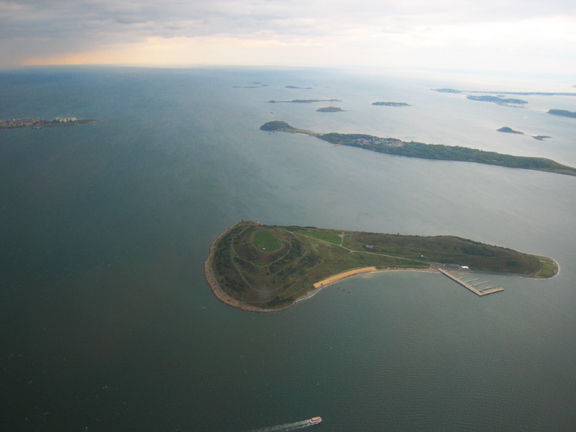
Boston Harbor Islands
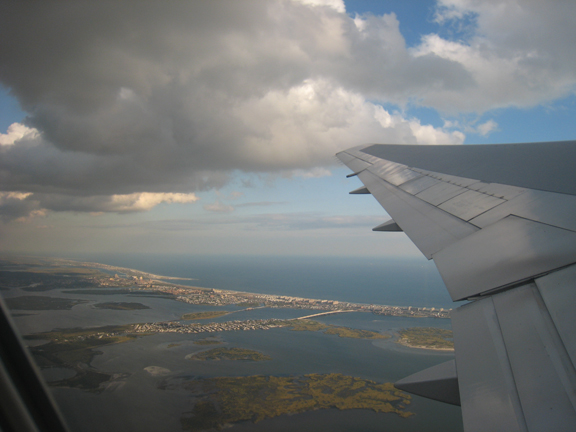
The bottom edge of Long Island from the air, arriving at JFK. From NYC to Moscow, we had center seats, so no photos as we landed in Russia.
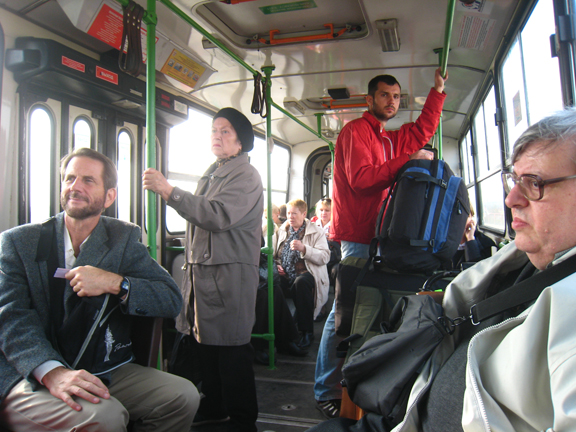
We left Boston on Friday afternoon, arrived in Moscow on Saturday morning, then had 14 hours in Moscow before the 2nd overnight flight to Novosibirsk. We were hosted in Moscow by Grisha, friend of Robert's Russian colleague at Northeastern. We went around Moscow by bus & subway and of course on foot.
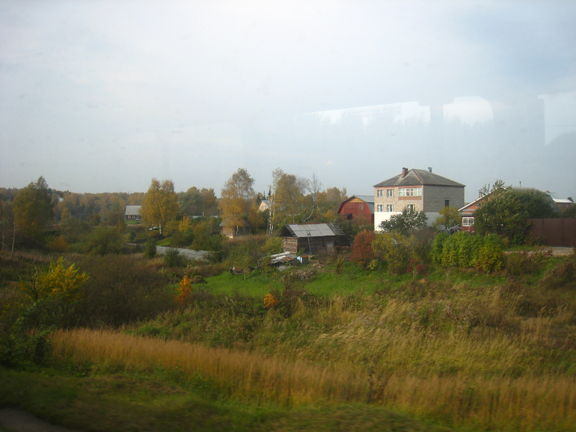
A pretty scene on the way from the airport into the city.
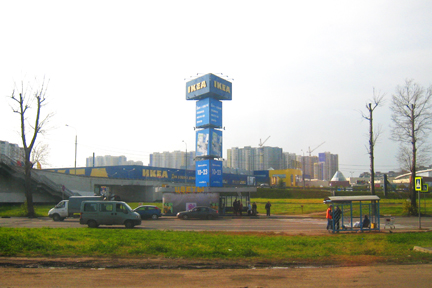
A familiar place.
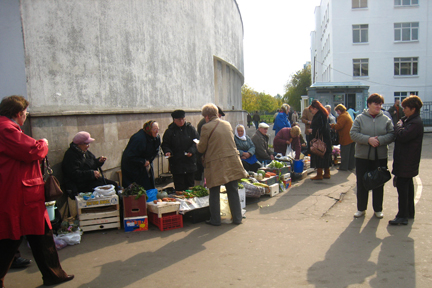
A street market
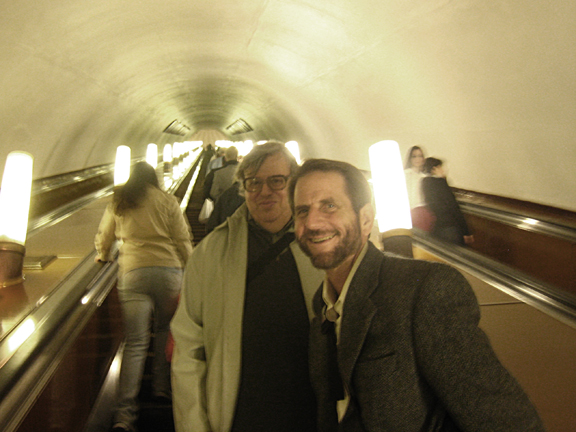
The escalator coming up from the subway station Belorusskaya. It's way deep down - we're at least 2/3 of the way up, and we can now see the top of the escalator. The underground station was meant to double as a bomb shelter. All the stations we saw were really nice, and this one fairly took my breath away. Turns out it's famous. See more photos later on on our way back.
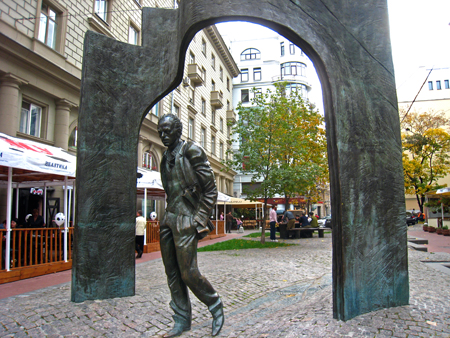
Along Arbat Street, famous Moscow pedestrian shopping, restaurant and art district. This is a statue of the Russian poet Bulat Okudzhava (1924-1997). There are lots of statues around, and Grisha knew all of them. And he knows the works of poets, writers, composers.
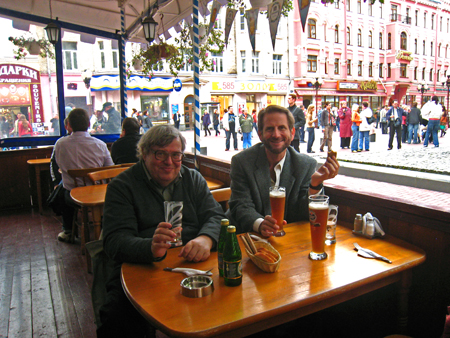
We're having lunch at a German restaurant on Arbat Street.
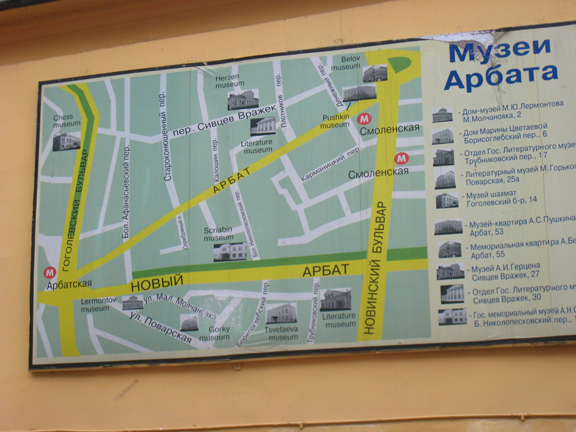
A wall map of the area. We're walking east towards the Kremlin.
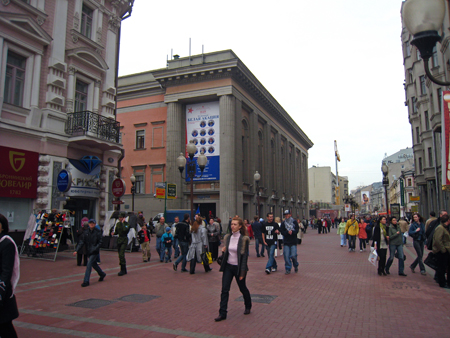
That's a theater on the left with the columns.
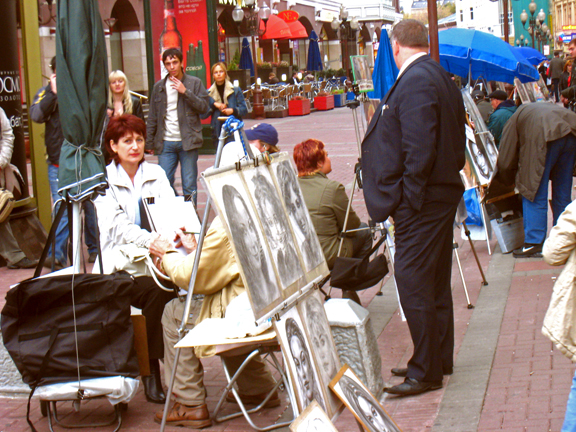
There were lots of artists showing their work on racks along the street. Many of them would do sit-down portraits - there were many styles - you could choose a style then sit and have a portrait done.
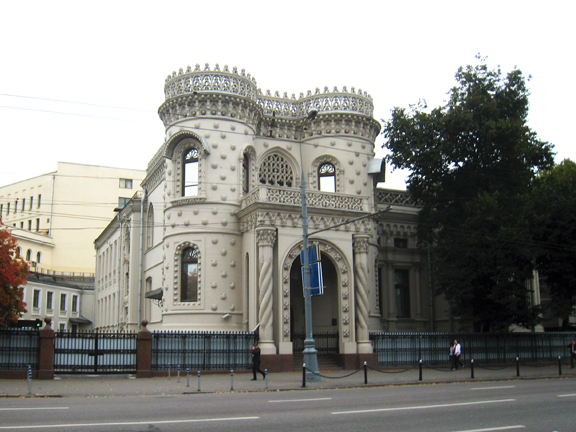
We're walking from Arbat Street towards the Kremlin; this is a pretty building, used to be the Spanish Embassy, now a part of the KGB.
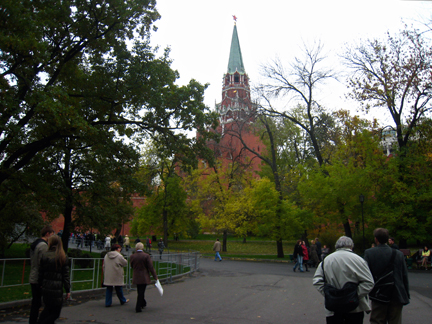
Approaching Alexander Gardens, which runs along one of the three sides of the Kremlin. One of the red brick Kremlin towers is visible. Beautiful gardens.
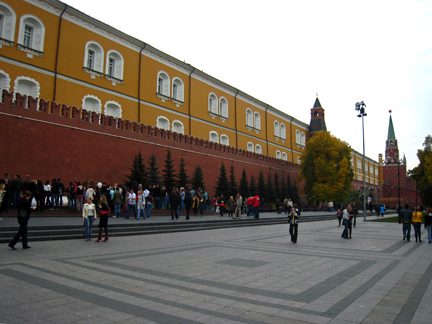
Looking back along the Kremlin wall. The wall is the red brick, the buildings inside are the yellow brick.

We've turned the corner into Red Square. "Red" is really supposed to be translated as "beautiful." Kremlin wall on the right, with the Tomb of Lenin partway along, the main Kremlin tower, Spasskaya Tower, at the far end of the wall, and St Basil's Cathedral straight ahead at the other end of the square. The painted yellow lines are for the tanks in the military parades.
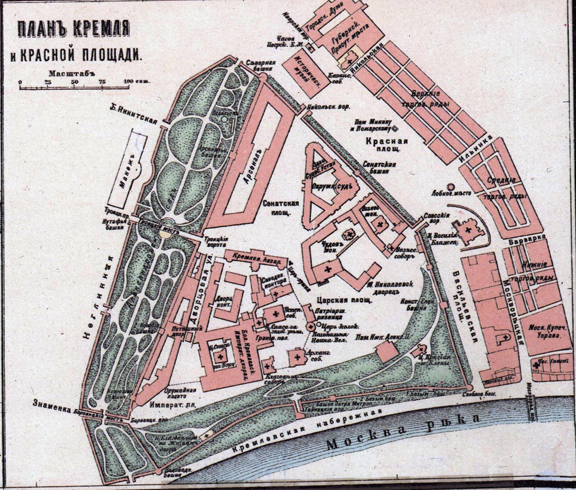
A little map of the Kremlin. "Kremlin" means "walled city" - it's a generic term that has come to mean this particular Kremlin. It's the Russian equivalent of the White House - it's the residence of the leader of Russia. We walked along two sides of the Kremlin - the Alexander Gardens on the left and Red Square on the right.
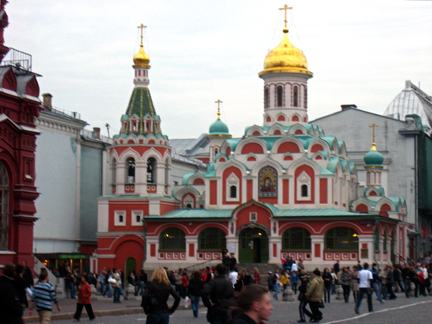
The other Russian church in Red Square, known as the Kazan Cathedral, built in the 1600s, meticulously restored in 1932, razed in 1936 to make room for the wartime parades, and rebuilt in 1992.
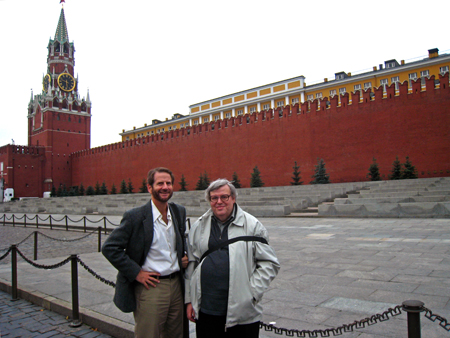
Robert and Grisha in front of the main tower of the Kremlin, called the Spasskaya Tower, with the clock sometimes known as the "Big Ben" of Moscow (it's officially 5:50 pm).
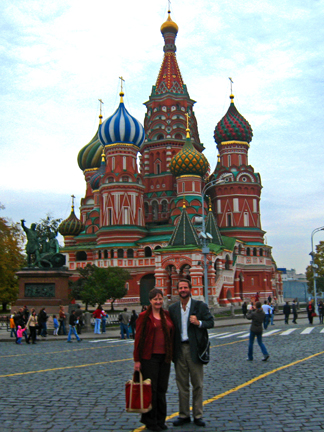
And the famous St. Basil's Cathedral. Commissioned by Ivan IV to commemorate the end of the Russo-Kazan wars in the mid 1500s. It's named after St. Basil, who died just about the same time the cathedral was built. St. Basil stole from the rich and gave to the poor; he rebuked Ivan the Terrible for his treatment of the disenfranchised, and the Czar was actually one of his pallbearers. The cathedral was slated to be demolished in the 30s like the Kazan Cathedral, but when the church was removed in the proposed model, Stalin said "Put that back!"
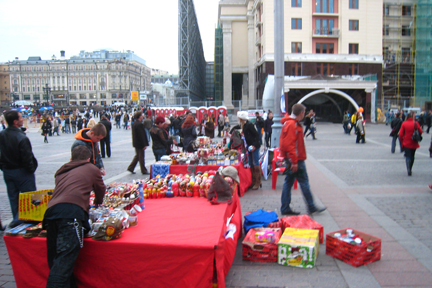
Souvenirs outside Red Square.

Downtown Moscow outside Red Square. Lots of lights & traffic.
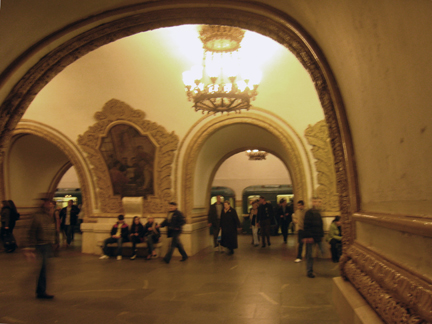
The Spasskaya subway station again. It's really beautiful, with arches, wonderful lighting, and all sorts of mosaics, carvings and painted plaques.
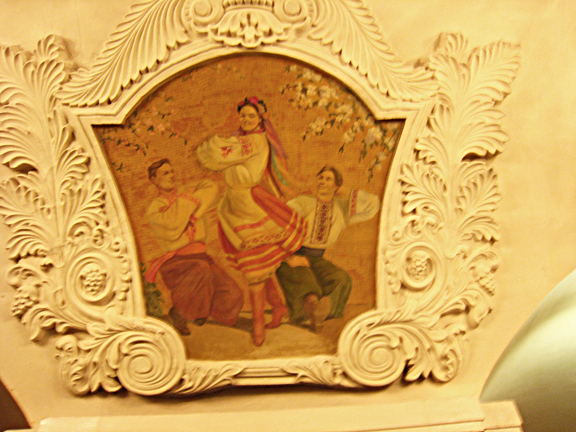
There are hundreds of these large painted or mosaic medallions - here are dancers.
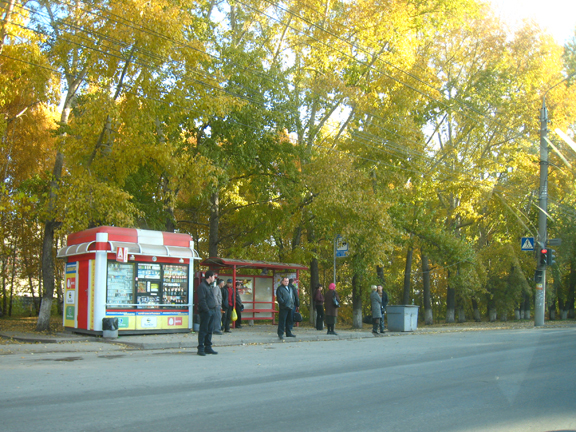
It's now the next morning, Sunday, we've flown the 5-hour 3-timezone flight east to Novosibirsk, and then are driven about an hour outside of the city to Akademgorodok, "Academic Town," set in the birch and pine Siberian forest by the Ob Sea. This is just a typical bus stop with a vendor station. These little vendor shops were all over the place.
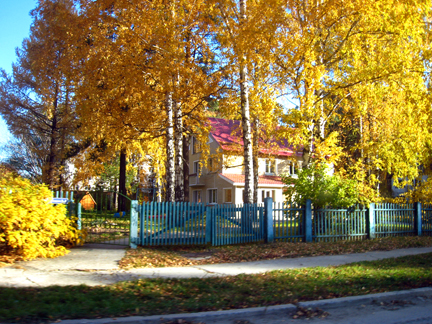
The streets and buildings and institutes are carved out of the forest. Here's a very nice house.
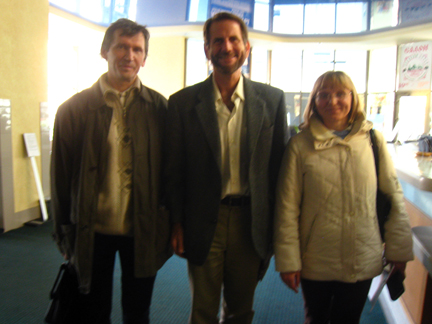
Our hosts Gennadii and Inessa. They are the leaders of the Conference Dedicated to the 100th Anniversary of the Birthday of Sergei Sobolev. Sobolev is one of Russia's most famous mathematicians, and Robert has worked with his theorems most of his academic life. We're in the lobby of the hotel where we'll be staying.
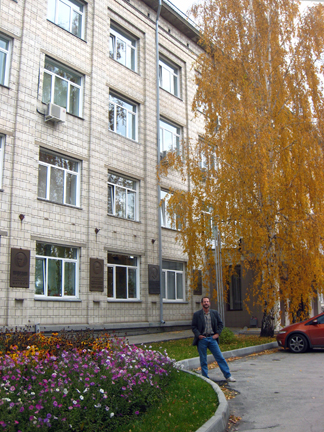
This is the Sobolev Institute, founded in 1957 by Sobolev. This is a small part of the building. It's about a mile from the hotel - you can walk or drive along the streets, a rather indirect route, or take a short cut through the forest.
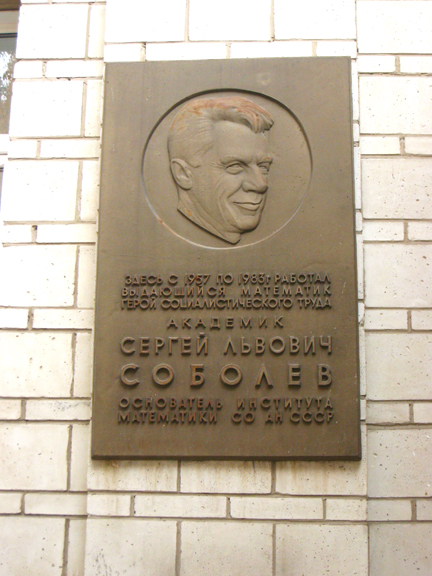
A plaque of Sobolev at the front entrance of the Institute.
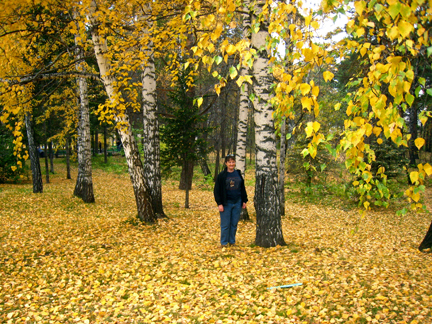
On our way back to the hotel. Peak foliage!
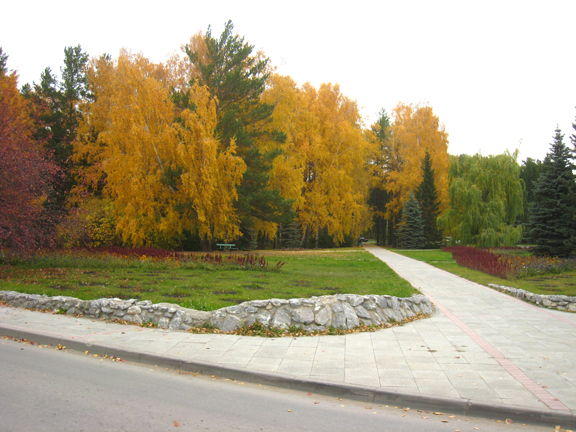
A pretty scene with different kinds of trees. Taken through the window from a coffee shop.
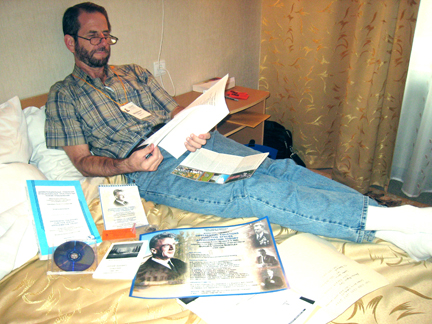
Robert's looking over the Conference material.

Sunday night - The opening reception of the conference. Lots of food & drink & conversation.
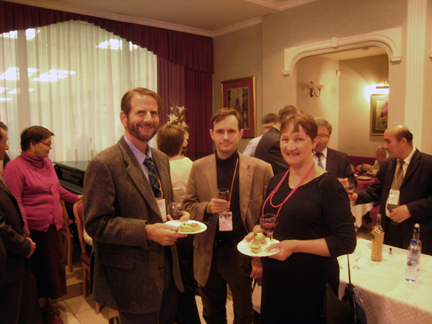
We met Antti, a mathematician from Finland, one of the few English-speakers at the conference.
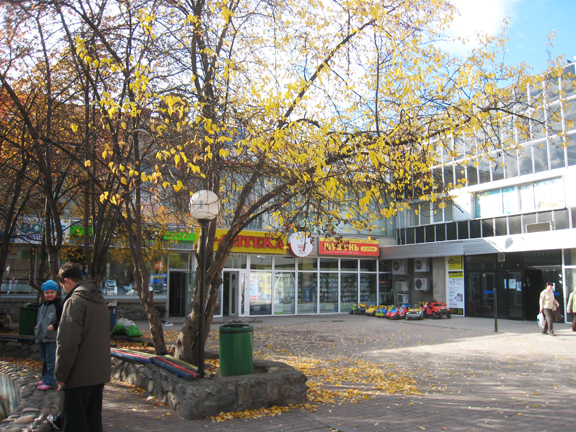
There was a little shopping area around the corner from the hotel - this is the supermarket I went to a few times to pick up stuff. We had a refrigerator in our room, and we made a sandwich or a snack for a meal about once a day instead of going out.

Robert went to talks mornings and afternoons. On Tuesday I walked to the beach.

At the beach. It's pretty deserted though it's an unusually nice day in October.
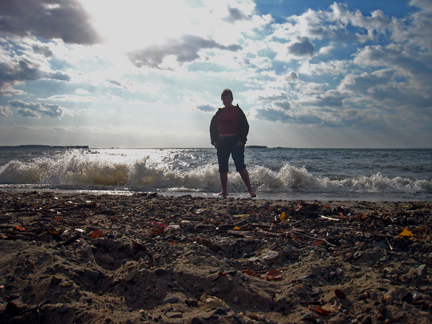
Frolicking barefoot in the little waves. The Ob Sea is man-made from a part of the Ob River. It's the water source for the area, and also meant to be an attraction for distinguished scientists to move to Akademgorodok.
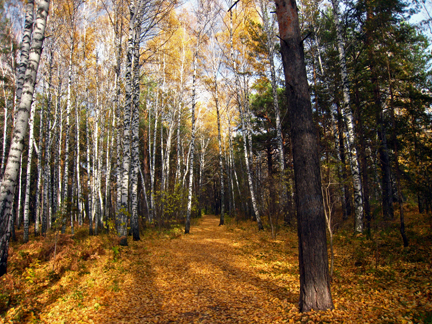
Walking back through the forest.
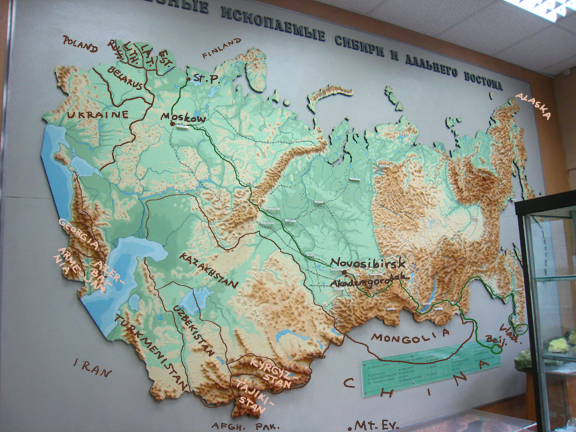
After the beach, I met up with Robert and Antti and a couple of others, and there was a guided tour through a geological museum. There were lots of specimens of precious and semi-precious stones, and this big map on the wall. It's from Soviet days, so I've divided off the satellite countries, and also marked the routes of the Trans-Siberian Railway, from St. Petersburg through Moscow and Novosibirsk, and dividing at the eastern end to Vladivostok and Beijing. It looks like Moscow is way north of Novosibirsk, but they're actually both about the same latitude - 55N - and also the same as Edinburgh - the latitude "line" is more of a circle arcing across the country. The Ural Mountains, which are the traditional boundary between Europe and Asia, are clearly visible.
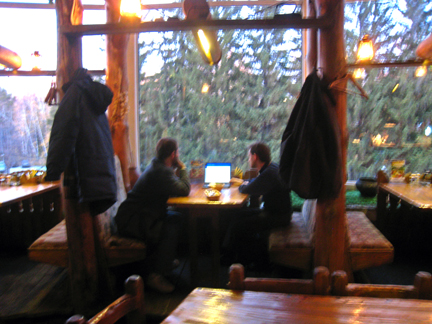
Robert and Antti and I found a great Russian restaurant down the street from the hotel. Antti is helping Robert re-format the presentation for his talk.
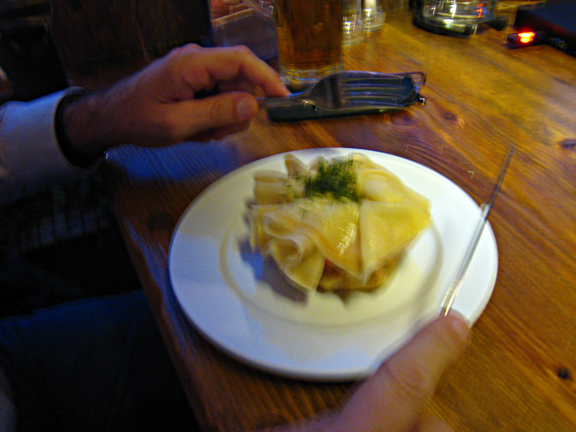
Pelmeni - the "Siberian ravioli."
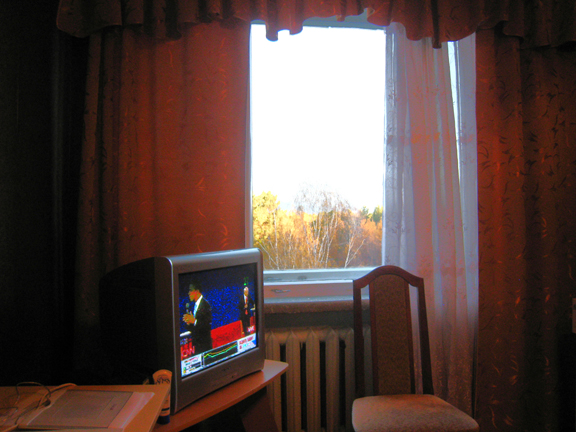
We watched the debate live on CNN on Wednesday morning.
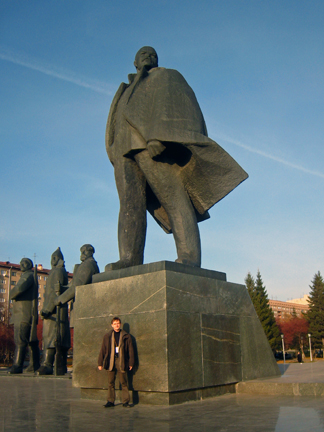
A bus excursion into Novosibirsk on Wednesday to see the ballet. First, we walked around the city center. There are three groupings of monumental statues - this is Antti in front of Lenin's statue.
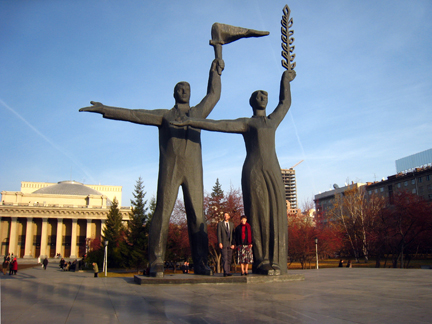
This pair honors the workers. The State Academy Opera and Ballet Theater is in the background.

The lobby of the Theater. It is the largest theater in Russia. It opened during the war in 1945. There was a time during the war when it was thought that the government of the Soviet Union might have to move east, and Novosibirsk was considered a likely location, so the theater was re-designed in mid-stream to be quite grand.
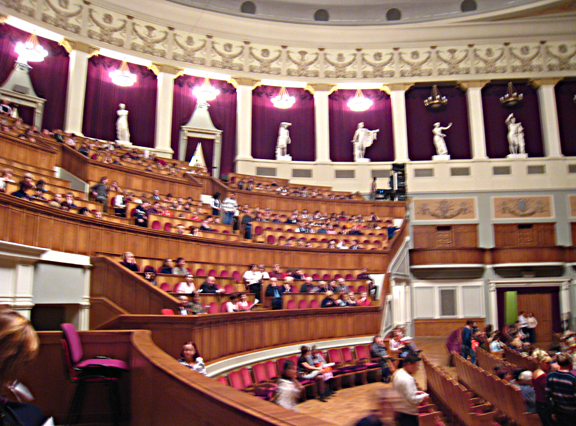
Inside the theater. It has a seating capacity of 2000. We saw a most interesting ballet, called Juno and Avos. It's a "fantasy ballet on the subject of a rock opera." It's actually part of a true story about the 19th-century Russian explorer Count Rezanov who wants to annex California to Russia, and falls in love with Conchita, the daughter of the commandante of San Francisco. We'd never heard of this ballet and it was most amazing.
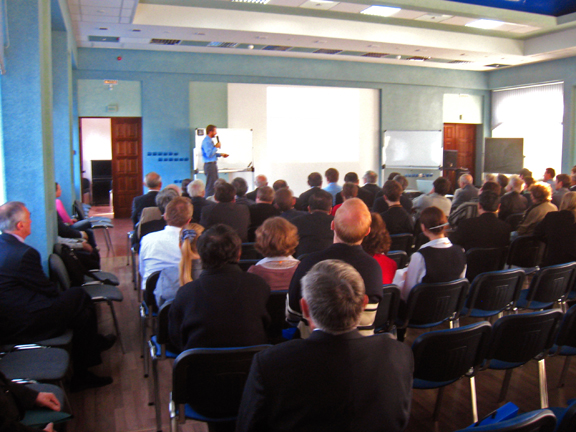
Robert is giving his talk on Thursday morning. He was a "plenary speaker," and the only American at the Conference, both quite an honor. His talk was 45 minutes, in English (spoken slowly and distinctly), with English slides. His talk was titled On the fundamental solution of an elliptic equation in nondivergence form.
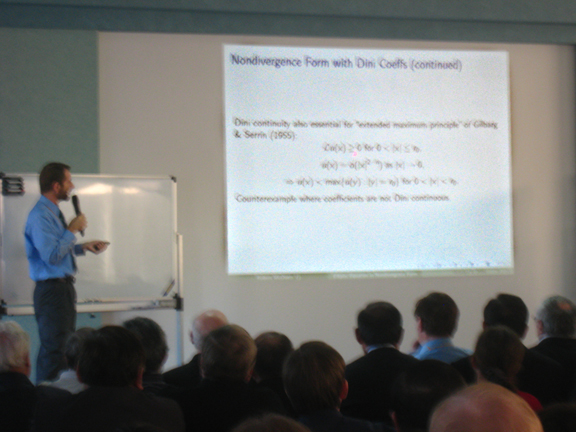
A better view of the slide. Most of the other talks were in Russian, some with English slides and some with Russian slides.
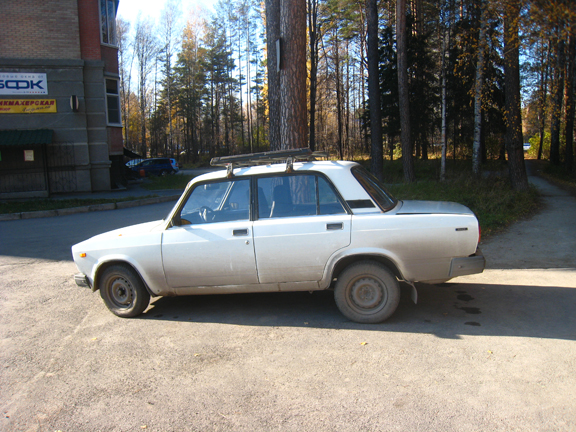
After the talk I walked back to the hotel, decided to take a photo of a Russian car. I think it's a Volga from the mid-1990s. There are lots of foreign cars in Russia, but the Russsian ones look distinctive, even to my untrained eye.
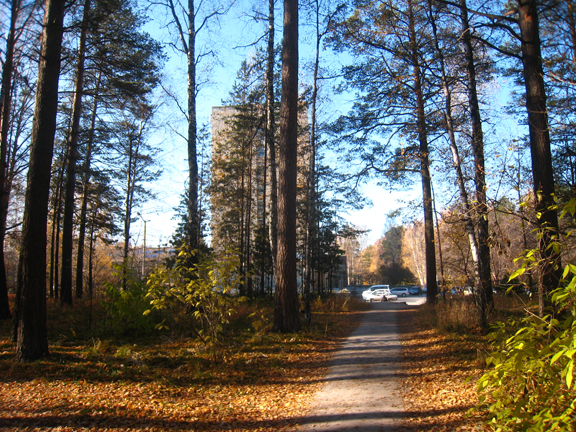
Our hotel is the big building behind the trees.
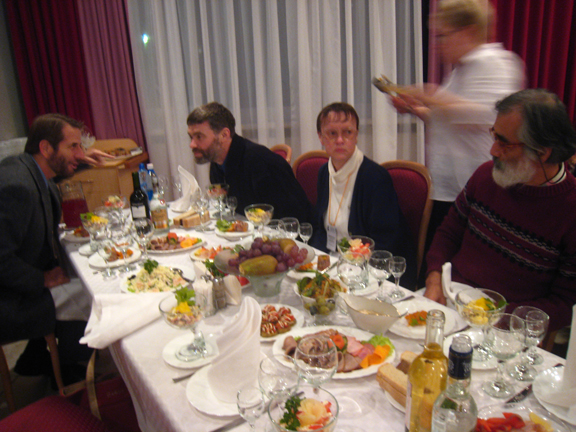
The celebration dinner on Thursday night at the Conference. These are the hors d'oeuvres.

Robert was asked to say a few words. He's in the back corner.
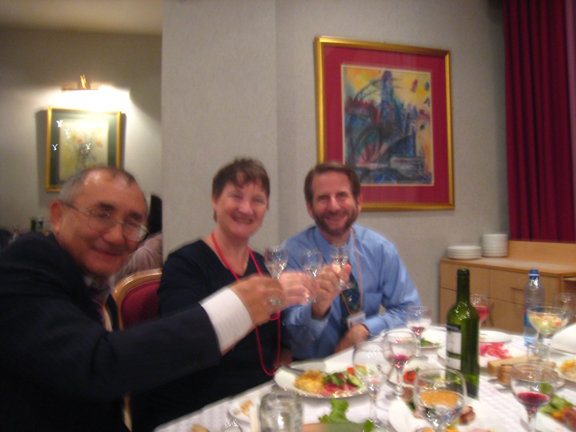
Vashe zdorov'ye! With our new friend from Kazakhstan.
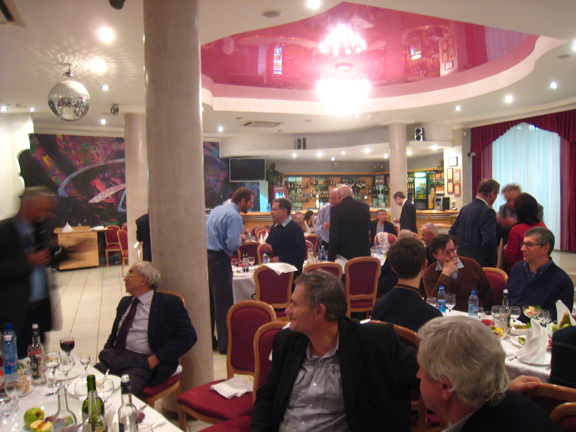
Robert is talking with Plamenevski; he had read his paper with Maz'ya many years ago.
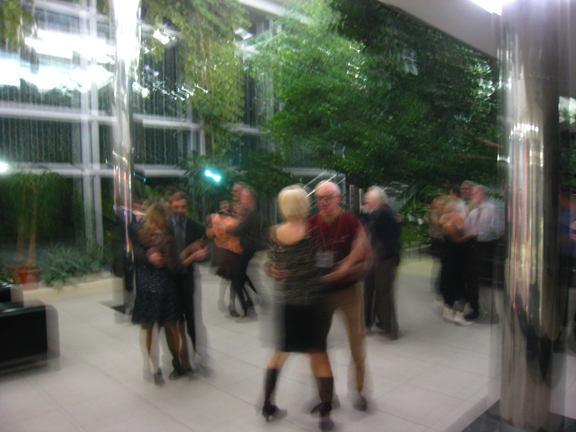
Waltzing mathematicians.
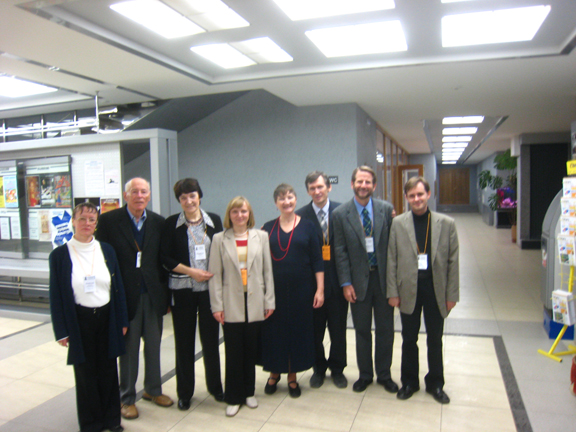
Includes Gennadii, Inessa and Antti.
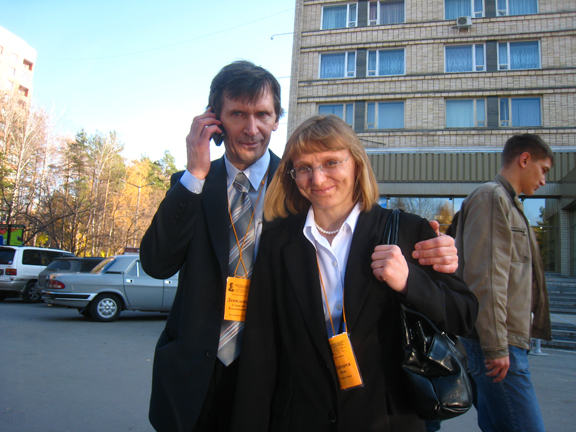
Friday afternoon - A fond farewell from Gennadii and Inessa.
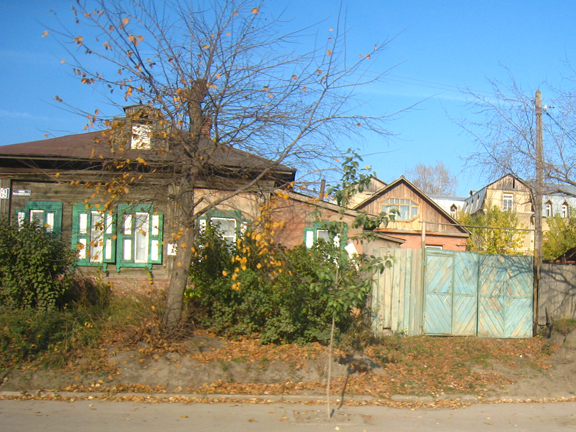
We're being driven to the train station in Novosibirsk to begin our journey home. Scenes along the way from the car. I really loved the wooden houses, with the different patterns of wood, the colors, the variously sloping roofs, and interesting windows.
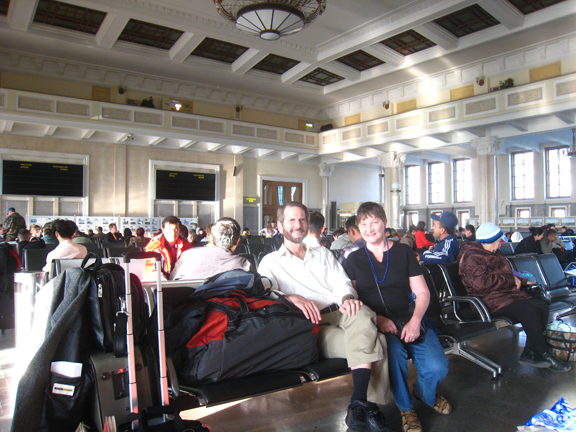
In the Novosibirsk Station.

A bigger view.
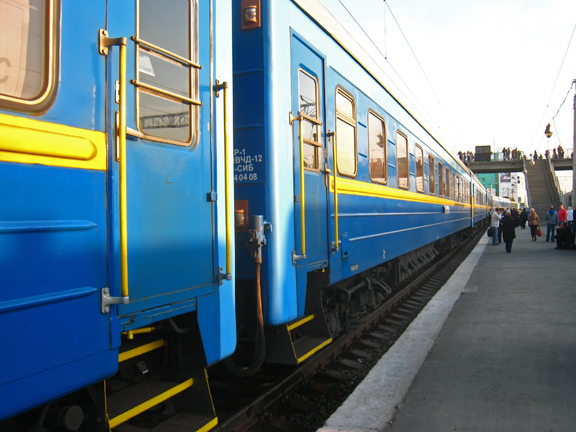
The Trans-Siberian Railroad Train - our home for the next two days. Actually, there are a bunch of trains, with different routes, speeds, comfort levels. Gennadii picked one of the good ones for us. The railway was built around the turn of the last century - Czar Nicholas laid the first cornerstone in Vladivostok in 1891 and it was completed in 1916.
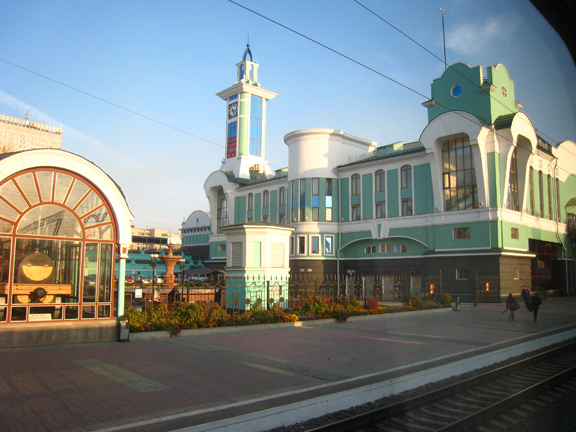
We're just pulling out of the station - it's 5 pm Friday. Here's a view of this famous station, one of the biggest ones on the 6000-mile train route. It looks rather art deco. I think it was built in the 30s.
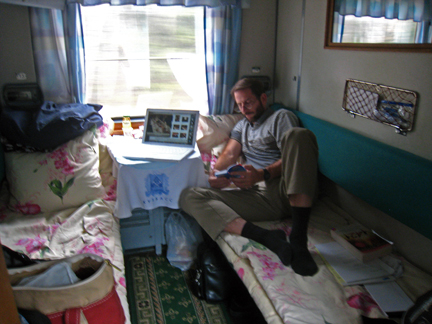
Saturday after breakfast. Glad we got the double, as opposed to the quadruple compartment (same size). We were very comfortable here. The toilet (no shower) was down the corridor, we had a hot meal brought in each day, and had brought along some nice snacks too. And good books.
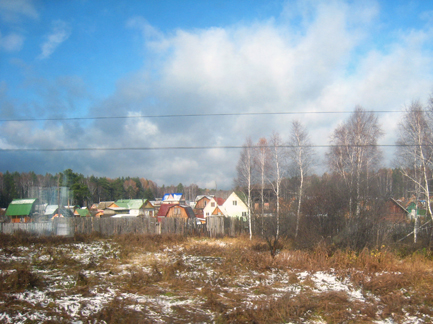
Saturday afternoon. This was the only snow we saw on the trip. Very pretty little villages, sometimes with brightly-colored houses.
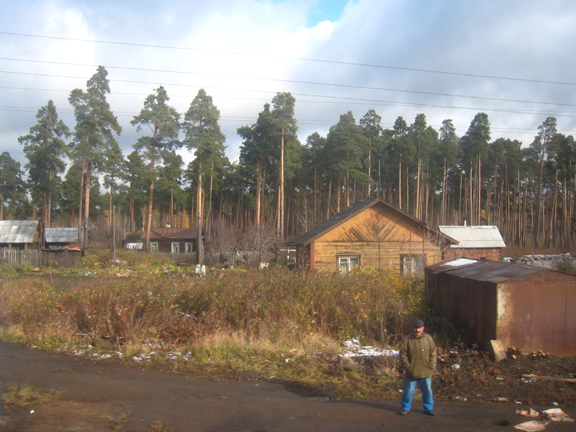
Man waiting on a dirt road. Wooden houses, a storage shed, trees.

3 pm - It's either a late lunch or early supper. Yum!
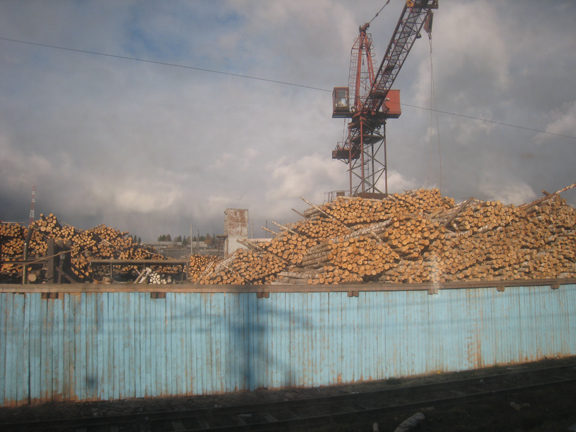
This is a mighty big woodpile - it took us many seconds to pass it.
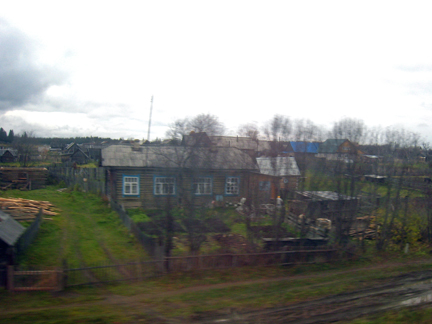
Scenes from the train. Interesting-shaped houses.
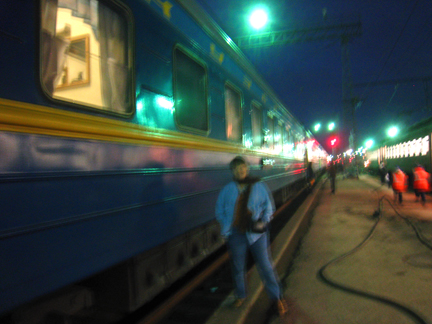
A 20-minute night-time stop, Saturday night 9 pm.
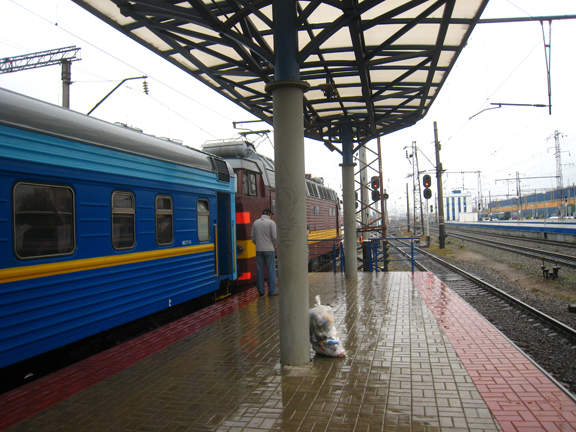
The little engine that could. It's Sunday morning 9 am, raining a little.
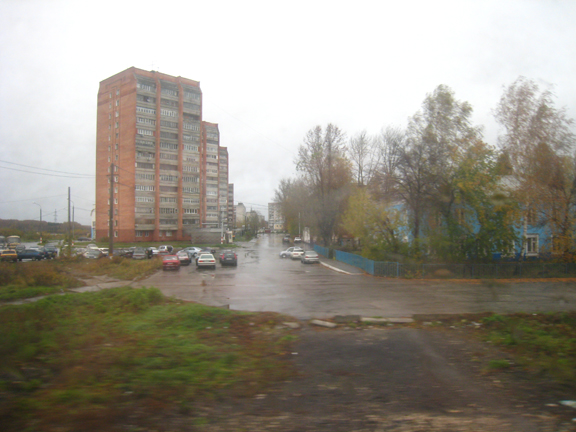
Houses & high-rises.
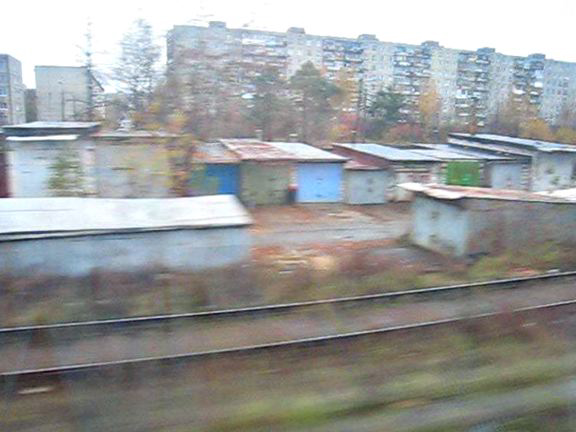
We kept passing little groups of sheds or garages. Perhaps these are associated with the high-rises behind.
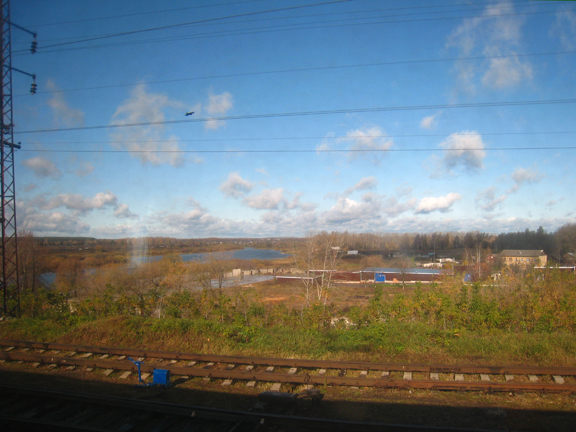
A pretty scene. We're about to go over some river.
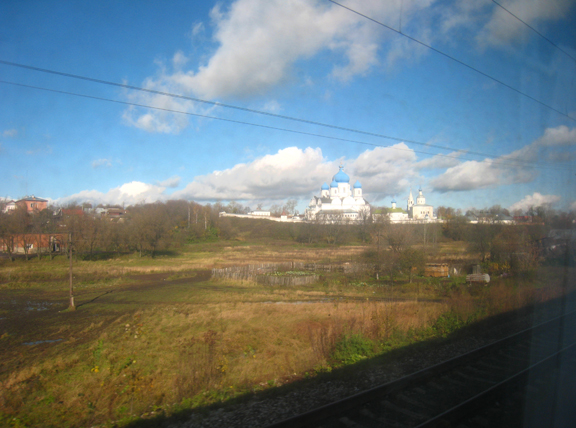
A Russian church blends in with the clouds. It's around noon on Sunday.
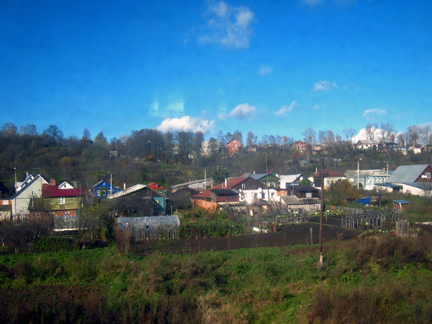
A village.
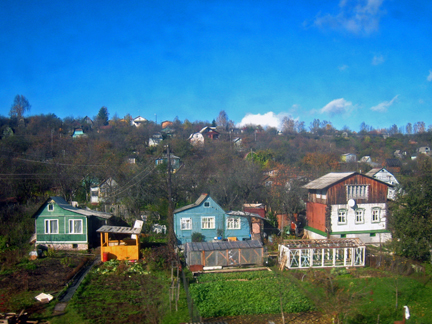
Houses with gardens/farms.
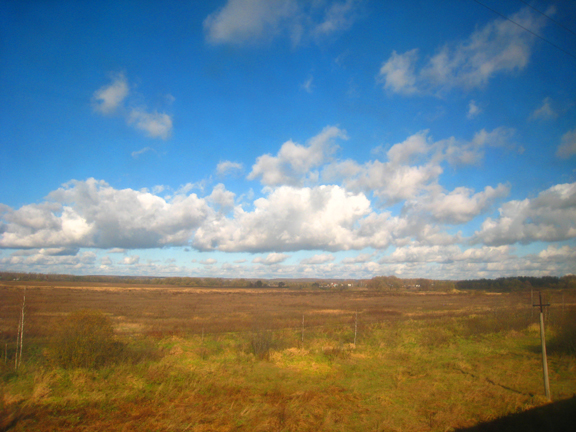
Plains - a common sight.
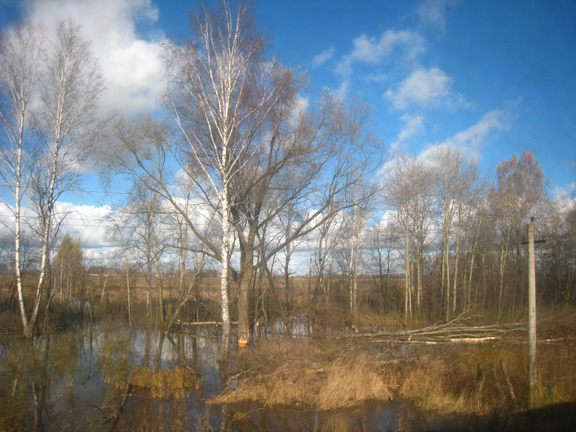
Birch trees, and ...

More trees, another common sight. We coming towards the end of the train trip.
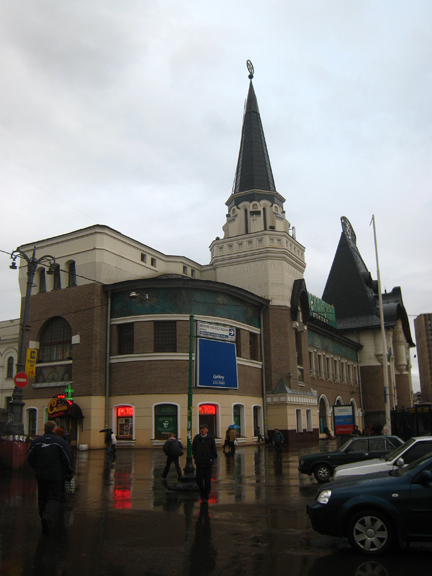
We've arrived in Moscow! It's 4:20 pm, and we're met at our "door" by Grisha and his two friends. As we leave the station, I get a photo of part of the Moscow train station.
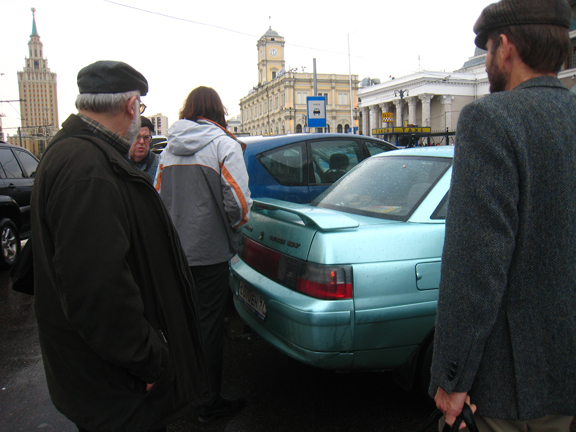
We're loading the car. I forgot to get a photo of everybody, so this is it.
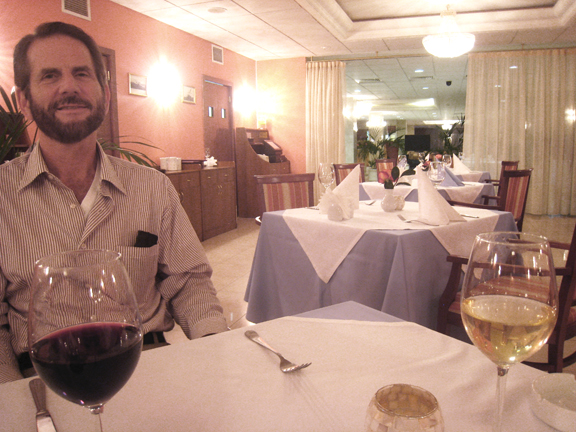
Our dinner at the elegant, expensive, and only restaurant anywhere in the area, at the airport hotel. On Monday morning we walked our stuff over to the terminal, spent the rest of our rubles, and arrived home around 5 pm.


















































































